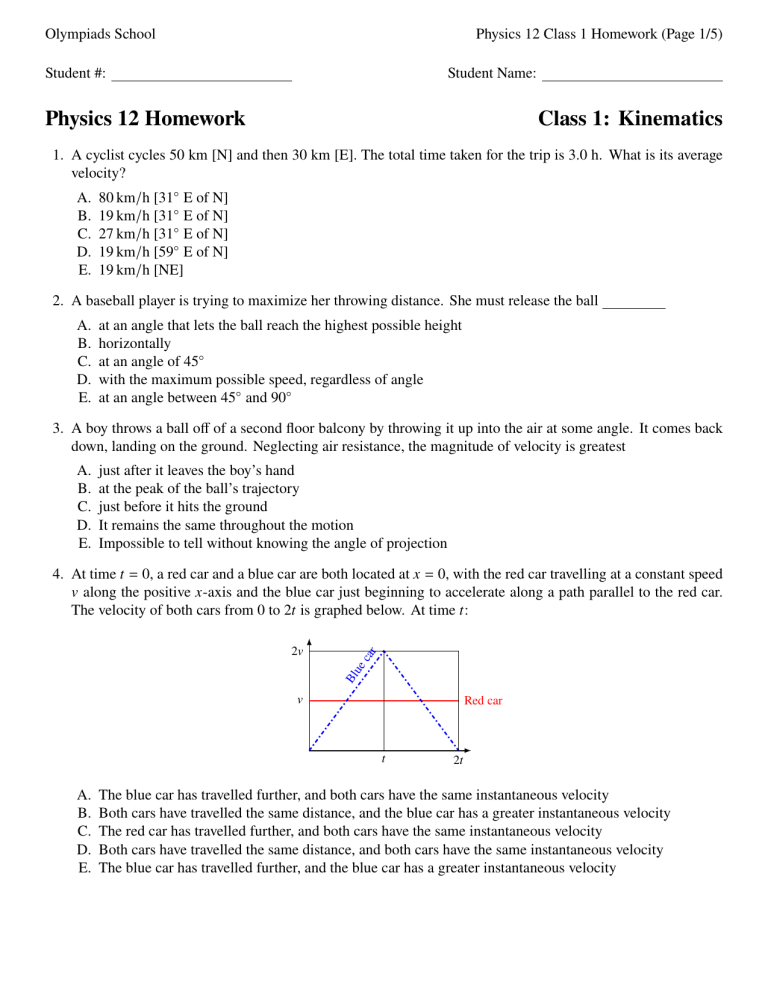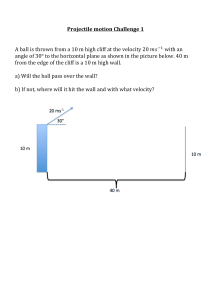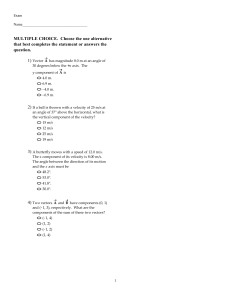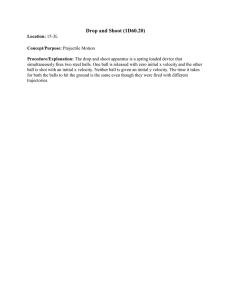
Olympiads School Physics 12 Class 1 Homework (Page 1/5) Student #: Student Name: Physics 12 Homework Class 1: Kinematics 1. A cyclist cycles 50 km [N] and then 30 km [E]. The total time taken for the trip is 3.0 h. What is its average velocity? A. B. C. D. E. 80 km/h [31◦ E of N] 19 km/h [31◦ E of N] 27 km/h [31◦ E of N] 19 km/h [59◦ E of N] 19 km/h [NE] 2. A baseball player is trying to maximize her throwing distance. She must release the ball A. B. C. D. E. at an angle that lets the ball reach the highest possible height horizontally at an angle of 45◦ with the maximum possible speed, regardless of angle at an angle between 45◦ and 90◦ 3. A boy throws a ball off of a second floor balcony by throwing it up into the air at some angle. It comes back down, landing on the ground. Neglecting air resistance, the magnitude of velocity is greatest A. B. C. D. E. just after it leaves the boy’s hand at the peak of the ball’s trajectory just before it hits the ground It remains the same throughout the motion Impossible to tell without knowing the angle of projection 4. At time 𝑡 = 0, a red car and a blue car are both located at 𝑥 = 0, with the red car travelling at a constant speed 𝑣 along the positive 𝑥-axis and the blue car just beginning to accelerate along a path parallel to the red car. The velocity of both cars from 0 to 2𝑡 is graphed below. At time 𝑡: Bl ue c ar 2𝑣 Red car 𝑣 𝑡 A. B. C. D. E. 2𝑡 The blue car has travelled further, and both cars have the same instantaneous velocity Both cars have travelled the same distance, and the blue car has a greater instantaneous velocity The red car has travelled further, and both cars have the same instantaneous velocity Both cars have travelled the same distance, and both cars have the same instantaneous velocity The blue car has travelled further, and the blue car has a greater instantaneous velocity Olympiads School Physics 12 Class 1 Homework (Page 2/5) 5. A car is travelling west and approaching a stop sign. As it is slowing to a stop, the directions associated with the object’s velocity and acceleration, respectively, are A. B. C. D. E. West, East West, West East, East East, West There is not enough information to tell 6. Two velocity vectors 𝑣 1 and 𝑣 2 each have the same magnitude. Graph 1 shows the velocity 𝑣 1 at 𝑡 = 0 s, and then the same object has a velocity 𝑣 2 at 𝑡 = 2 s, shown in Graph 2. Which of the following vectors best represents the average acceleration vector that causes the object’s velocity to change from 𝑣 1 to 𝑣 2 ? 𝑣2 𝑣1 A. B. C. D. E. 7. A ball is dropped from rest from the top of a cliff 80 m high. At the same time, a rock is thrown horizontally from the top of the same cliff. The rock and ball hit the level ground below a distance of 40 m apart. The horizontal velocity of the rock that was thrown was most nearly 𝑣 80 m A. B. C. D. E. 5 m/s 10 m/s 20 m/s 40 m/s 80 m/s 40 m 8. A golf ball is hit from level ground and has a horizontal range of 100 m. The ball leaves the golf club at an angle of 60◦ to the level ground. At what other angle(s) can the ball be struck at the same initial velocity and still have a range of 100 m? 𝑦 𝑣 A. B. C. D. E. 30◦ 60◦ 𝑥 ◦ ◦ 20 and 80 10◦ and 120◦ 45◦ and 135◦ There is no other angle other than 60◦ in which the ball will have a range of 100 m. Olympiads School Physics 12 Class 1 Homework (Page 3/5) 9. The motion of an object is represented by the acceleration vs. time graph below. If the object is initially at rest, which of the following statements is true about its motion? 𝑎 +2 𝑡 2 4 −2 A. B. C. D. E. The object returns to its original position. The velocity of the object is zero at a time of 2 s. The velocity of the object is zero at a time of 4 s. The displacement of the object is zero at a time of 4 s. The acceleration of the object is zero at a time of 2 s. 10. Because of an oncoming storm, a boat must cross a river in the shortest amount of time possible regardless of where it lands on the opposite shore. Given that the river has a current, in what direction should the boat point? Explain. 11. While hiking in the wilderness, you come to the top of a cliff that is 60 m high. You throw a stone from the cliff, giving it an initial velocity of 21 m/s at 35◦ above the horizontal. How far from the base of the cliff does the stone land? Olympiads School Physics 12 Class 1 Homework (Page 4/5) 12. You want to shoot a stone with a sling shot and hit a target on the ground 14.6 m away. If you give the stone an initial speed of 12.5 m/s, neglecting friction and air resistance, what is/are the launch angle(s) in order for the stone to hit the target? What would be the maximum height(s) by the stone? What would be its time of flight? Assume motion is symmetric. 13. A projectile is launched from point 𝑂 at an angle of 22◦ with an initial velocity of 𝑣 0 = 15 m/s up an incline plane that makes an angle of 10◦ with the horizontal. The projectile lands on the incline plane at point 𝑀. 𝑣0 22◦ 𝑀 10◦ 𝑂 (a) Find the time it takes for the projectile to hit the incline plane. (b) Find the distance 𝑂 𝑀. Olympiads School Physics 12 Class 1 Homework (Page 5/5) 14. A baseball is thrown by an outfielder (𝑂) towards the catcher (𝐶) with an initial speed of 20 m/s at an angle of 45◦ with the horizontal. At the moment that the ball is thrown, 𝐶 is 50 m from 𝑂. At what speed and in what direction must 𝐶 run to catch the ball at the same height at which it was released? Assume that 𝐶 catches the ball at the same moment that it arrives. Please answer in two significant figures. 15. A car is travelling north on a city street at 12.5 m/s. Just as the car crosses a perpendicularly intersecting crossroad, the passenger throws out a can horizontally, towards the east. The initial speed of the can relative to the car is 10.0 m/s. It is released at a height of 1.75 m above the road. (a) What is the initial velocity of the can relative to the road? (b) Where does the can land relative to the centre of the intersection?





